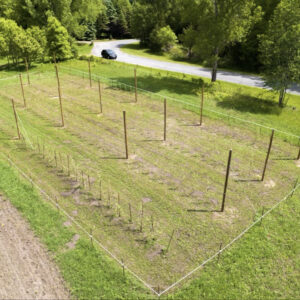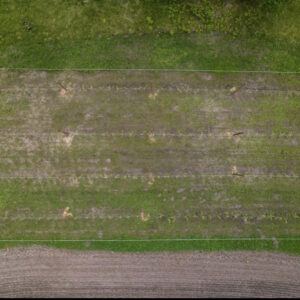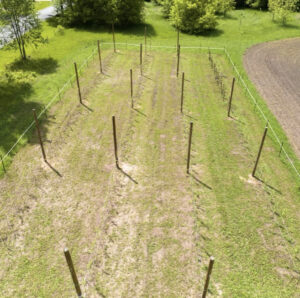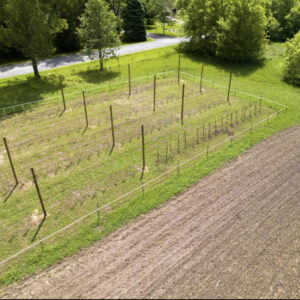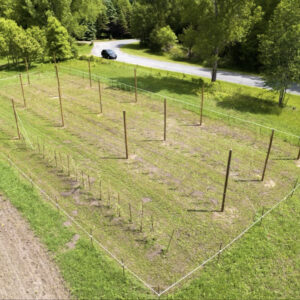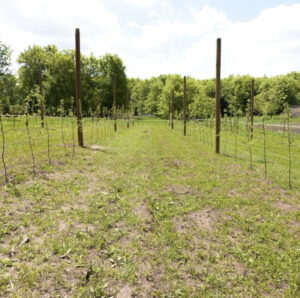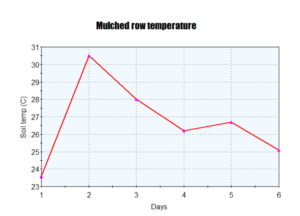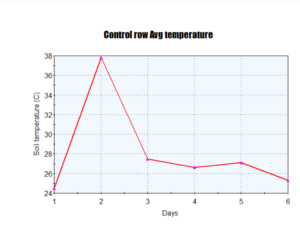Final report for FNC21-1294
Project Information
I am a first generation apple grower in Western Wisconsin. Being only 16, I have 2 acres of operation in all apples. The operation is only 2 years old but is well on its way. Before the grant I hadn't learned of too many organic practices that I was using. I used mostly one biological insecticide which was DP (Bacillus thuringiensis v. kurstaki bacteria) a strain of bacteria that kills Cydia pomonella (codling moth) and other Cydia relatives. Once I received the grant I was able to experiment with some groundbreaking products that I have seen really great potential for utilizing in my orchard.
The problem I am trying to solve is reducing or eliminating the use of harsh fungicides and insecticides by using organic practices in apple growing. The first step is utilizing pheromone disruption as one of the main practices. Pheromone disruption is the use of pheromones to disrupt the female and the male insect so they can't reproduce. This will greatly reduce insecticide use as it reduces the number of insects. The main insect I’m targeting with pheremone disruption is the Codling Moth. It gets into the apple as a small larvae and makes it bumpy. There are a few forms of organic disruption: "Puffers" and pheromone strips. Puffers are on a timer and will puff out pheromones at certain intervals. Strips will sit on the tree and passively put off the pheromone. The second product I will use is Drape Net. It is a protective netting generally used for hail, but I think it can be used as an Integrated pest management (IPM) practice as the netting is fine and it won’t let insects in. I can easily tie it to the first wire of the trellis and it will protect the trees from any insects. I will also use various organic and biological sprays that can easily be sprayed through the netting.
1. Trial, test, and evaluate different organic sprays over 23 months. Look exactly at the effectiveness and long term vitality in fruit growing.
2. Test and evaluate different organic nutrients on Honeycrisp along with weekly applications of calcium.
3. Test drape net for an insect barrier in trellis systems. It is commonly used for hail protection.
4. Test and evaluate several pheromone disrupting products such as the CIDETRACK products.
5. Test and evaluate all these practices on several new cultivars that are Honeycrisp progeny because it has issues with disease.
Research
I am utilizing two different growing methods. The first method is "Tall Spindle Trellis System" and the other is staking the trees. I am more in favor of using the tall spindle as it is easier to implement the drape net and there is more airflow throughout the trees. I am using very straightforward spraying techniques with a focus on biological insecticides and organic compounds. These products will be requested from the other grant I am writing through the FFA SAE grant program. The first product is "Regalia". This product has the active ingredient Reynoutria sachalinensis, which, is an extract from the plant Reynoutria sachalinensis. It absorbs into the tree's canopy supporting the plant's ability to fight disease better and at the same time, it helps protect the fruit making a higher pack out. The second product, "Surround" is an organic talc-like product (kaolin clay) that coats the leaves and makes it harder for the fungus and or insect to infest the canopy. The third product, "Dr. Zymes" is an organic product that also acts as a protectant from fungus and insects. But this product can be used more or less to control insects when spotted because it will smother the insects right away. I will be following the Pheromone Disruption products of ECO Apple and experimenting with these organic products. It will take many different trials and combinations to get the insect tally down. The pheromone disruptors will be placed at the suggested length and the traps will be replaced and checked weekly. The idea is to get control of it early so there isn't a problem when the trees start to produce fruit. It will be crucial to document every single part of the process.
- Clearing of the land. The land had lots of trees and brush throughout the property so we had to come through and clear the trees and then pull out the stumps so there was not a threat of replant disease.
- Plowing of land- We needed to plow the land to even it out. Since it was pasture land it was really rough.
- Tilling of the land. Once the land was worked up we wanted to work the soil so it is clear from large pieces of sod. We went in with a tiller and went over it a few times.
- Putting in the posts. We had to dig 4 ft holes to avoid the frost line and then lift the 16 foot posts into the hole. There is then 12 feet out of the ground for the trellis component. The posts are spaced 30 feet apart from each other in the row and then 16 feet from each other in rows.
- Putting up the first wire. To stabilize the tree at planting it is important to have the first 2 foot wire up. We use 12.5 gauge wire and a tensioner. We make a loop with the tensioner on it that measures out to be 80IN of total wire making a consistent structure. We wrap the loop around twice on the one end and then staple it on the end and the sides. We then wrap the wire around the end post 2 times and then put a barbed staple on the back and sides to keep it from moving. We then cut the wire by the tensioner and pull it tight at the same time to reduce waste. Then follow the directions on the specific tensioner you're using.
- Planting the trees. Depending on your soil you will have different things you can do prior to planting. If you have high organic matter then you are fine. But if you have sand you should rely on a salt based fertilizer program. (Keep in mind that it is not Organic at that point. It would be what I like to call Hybrid Conventional.). I do not suggest putting compost in the planting hole as it can cause damage to the roots. When you plant make sure to make a hole large enough to fit the roots without them being constricted. Dig a hole the size of a 2 gallon bucket.
- Attaching to the trellis. Make sure to be prepared by buying U clips that attach to the wire beforehand. These can be found on many orchard supply websites. Make sure to attach them to the first wire with these at planting. This is especially important when Geneva 41® rootstock is being planted Geneva 41®.has a brittle union between the scion variety and rootstock itself. Extra care is needed when working with it. I have also seen brittleness with Honeycrisp on Geneva 969® as well. Honeycrisp is known to be brittle in general but it is not known if Geneva 969® has an impact.
- We had a very bad drought this year but the FFA alumni was kind enough to truck in water every few weeks. We gravity feed the water with a hose. It wasn’t ideal but it worked quite well for what we had at this point.
- Treatments this year included:
May 10th- Pherocon Meso-A Pheromone Disruptors.
May 10th- Pherocon trap.
May 15th- CLEAN Calcium foliar apply. 1 OZ per gallon.
May 20th ( Found Codling Moth in trap 1 so I applied Venerate at 2 OZ per gallon.
June 1st- Mixed 2 gallons of CLEAN Nitrogen and ½ Gallon of Micromix in 250 Gal.
June 20th. Applied Grandevo for Leafroller damage at the suggested rate of 2.5 OZ per gallon.
July 1st- Applied CLEAN SeaCal at 1 OZ per gallon foliar.
July 20th- Started finding Japanese Beetles and found that I could not control them with the products I was using so I put out Japanese Beetle traps and I got around 500 in 5 days.
Aug-22- Applied CLEAN magnesium at 1 OZ per gallon foliar to help the tree slowly shut down over the next month.
Pictures
During the course of the 2022 summer. I ran a trial with using mulch as a alternative to paraquat for weeds in the orchard row. I was successful with my hypothesis that it would reduce weeds. I was also able to collect data on the soil temperature at 2 inches below the soil.
My high school had a videographer do a video on my project:
Final Write-Up:
Educational & Outreach Activities
Participation Summary:
2021,
I was approved for an Independent Study at my High School where I will be writing an 18-page paper on my study's results. It will be done by February.
Matt Milkovich from the Good Fruit Grower visiting my project on Sept 1st. He did a write up on my project:
Wisconsin teen growing a fruitful future
The River Falls Journal ran a article on the project in the spring.
2022,
The River Falls High School used the project as a outside learning opportunity and field day. The students toured the project and were able to participate in other learning opportunity's on the property. 60 students total attended the tour.
Learning Outcomes
8-7-21 As of August in the first year I've taken away several aspects:
- Dormant oil spray. I've found that the most important time and spray is the one as soon as the buds break. This is when you can smother the overwintering eggs of numerous pests. Apply as the rate requires. My control group of trees showed a noticeable amount of Japanese Beetles and insects in the animalia kingdom.
- Lack of water. We lost a few this year due to drought but I was able to keep most trees alive with adequate watering. I did not meet my expected growth model but I am frankly happy to have trees alive.
- I did not apply netting this year because I didn't want to interfere with growth. I will apply netting to a small amount of trees next year.
11-27-22
- Western Wisconsin experienced another drought in the summer of 2022; because of the problems that occurred in 2022, some adjustments were able to take place. We were able to supplement moisture with drip irrigation. Growth was still down by 50%.
- I experimented with using mulch to reduce the amount of water that was needed and to help protect the soil moisture that was already in the ground. I'm now using mulch on all of my trees to create a barrier between the sun and the soil.
